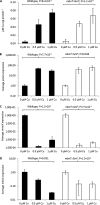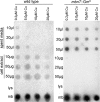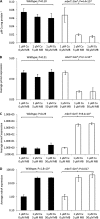A TonB-Dependent Transporter Is Responsible for Methanobactin Uptake by Methylosinus trichosporium OB3b
- PMID: 26773085
- PMCID: PMC4784032
- DOI: 10.1128/AEM.03884-15
A TonB-Dependent Transporter Is Responsible for Methanobactin Uptake by Methylosinus trichosporium OB3b
Abstract
Methanobactin, a small modified polypeptide synthesized by methanotrophs for copper uptake, has been found to be chromosomally encoded. The gene encoding the polypeptide precursor of methanobactin, mbnA, is part of a gene cluster that also includes several genes encoding proteins of unknown function (but speculated to be involved in methanobactin formation) as well as mbnT, which encodes a TonB-dependent transporter hypothesized to be responsible for methanobactin uptake. To determine if mbnT is truly responsible for methanobactin uptake, a knockout was constructed in Methylosinus trichosporium OB3b using marker exchange mutagenesis. The resulting M. trichosporium mbnT::Gm(r) mutant was found to be able to produce methanobactin but was unable to internalize it. Further, if this mutant was grown in the presence of copper and exogenous methanobactin, copper uptake was significantly reduced. Expression of mmoX and pmoA, encoding polypeptides of the soluble methane monooxygenase (sMMO) and particulate methane monooxygenase (pMMO), respectively, also changed significantly when methanobactin was added, which indicates that the mutant was unable to collect copper under these conditions. Copper uptake and gene expression, however, were not affected in wild-type M. trichosporium OB3b, indicating that the TonB-dependent transporter encoded by mbnT is responsible for methanobactin uptake and that methanobactin is a key mechanism used by methanotrophs for copper uptake. When the mbnT::Gm(r) mutant was grown under a range of copper concentrations in the absence of methanobactin, however, the phenotype of the mutant was indistinguishable from that of wild-type M. trichosporium OB3b, indicating that this methanotroph has multiple mechanisms for copper uptake.
Copyright © 2016, American Society for Microbiology. All Rights Reserved.
Figures





Similar articles
-
An Aminotransferase Is Responsible for the Deamination of the N-Terminal Leucine and Required for Formation of Oxazolone Ring A in Methanobactin of Methylosinus trichosporium OB3b.Appl Environ Microbiol. 2016 Dec 15;83(1):e02619-16. doi: 10.1128/AEM.02619-16. Print 2017 Jan 1. Appl Environ Microbiol. 2016. PMID: 27795312 Free PMC article.
-
Methanobactin from Methylocystis sp. strain SB2 affects gene expression and methane monooxygenase activity in Methylosinus trichosporium OB3b.Appl Environ Microbiol. 2015 Apr;81(7):2466-73. doi: 10.1128/AEM.03981-14. Epub 2015 Jan 23. Appl Environ Microbiol. 2015. PMID: 25616801 Free PMC article.
-
Two TonB-Dependent Transporters in Methylosinus trichosporium OB3b Are Responsible for Uptake of Different Forms of Methanobactin and Are Involved in the Canonical "Copper Switch".Appl Environ Microbiol. 2022 Jan 11;88(1):e0179321. doi: 10.1128/AEM.01793-21. Epub 2021 Oct 20. Appl Environ Microbiol. 2022. PMID: 34669437 Free PMC article.
-
Chemistry and biology of the copper chelator methanobactin.ACS Chem Biol. 2012 Feb 17;7(2):260-8. doi: 10.1021/cb2003913. Epub 2011 Dec 12. ACS Chem Biol. 2012. PMID: 22126187 Free PMC article. Review.
-
Chalkophores.Annu Rev Biochem. 2018 Jun 20;87:645-676. doi: 10.1146/annurev-biochem-062917-012300. Epub 2018 Apr 18. Annu Rev Biochem. 2018. PMID: 29668305 Free PMC article. Review.
Cited by
-
Ecological Aerobic Ammonia and Methane Oxidation Involved Key Metal Compounds, Fe and Cu.Life (Basel). 2022 Nov 7;12(11):1806. doi: 10.3390/life12111806. Life (Basel). 2022. PMID: 36362966 Free PMC article. Review.
-
Aerobic methane oxidation under copper scarcity in a stratified lake.Sci Rep. 2019 Mar 18;9(1):4817. doi: 10.1038/s41598-019-40642-2. Sci Rep. 2019. PMID: 30886176 Free PMC article.
-
Methanobactins: from genome to function.Metallomics. 2017 Jan 25;9(1):7-20. doi: 10.1039/c6mt00208k. Metallomics. 2017. PMID: 27905614 Free PMC article. Review.
-
Bacterial copper storage proteins.J Biol Chem. 2018 Mar 30;293(13):4616-4627. doi: 10.1074/jbc.TM117.000180. Epub 2018 Feb 6. J Biol Chem. 2018. PMID: 29414794 Free PMC article. Review.
-
An Aminotransferase Is Responsible for the Deamination of the N-Terminal Leucine and Required for Formation of Oxazolone Ring A in Methanobactin of Methylosinus trichosporium OB3b.Appl Environ Microbiol. 2016 Dec 15;83(1):e02619-16. doi: 10.1128/AEM.02619-16. Print 2017 Jan 1. Appl Environ Microbiol. 2016. PMID: 27795312 Free PMC article.
References
-
- Myhre G, Shindell D, Breon F-M, Collins W, Fuglestvedt J, Huang J, Koch D, Lamarque JF, Lee D, Mendoza B, Nakajima T, Robock A, Stephens G, Takamura T, Zhang H. 2013. Anthropogenic and natural radiative forcing, p 659–740. In Stocker TF, Qin D, Plattner GK, Tignor MMB, Allen SK, Boschung J, Nauels A, Xia Y, Bex V, Midgley PM (ed), Climate change 2013: the physical science basis. Cambridge University Press, Cambridge, United Kingdom.
-
- Chowdury TR, Dick RP. 2013. Ecology of aerobic methanotrophs in controlling methane fluxes from wetlands. Appl Soil Ecol 65:8–22. doi:10.1016/j.apsoil.2012.12.014. - DOI
Publication types
MeSH terms
Substances
LinkOut - more resources
Full Text Sources
Other Literature Sources
Research Materials

